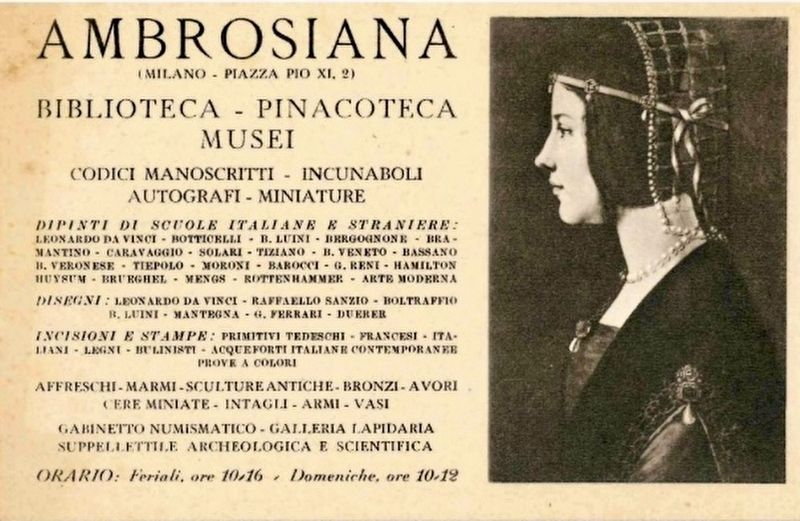Cerchia dei Navigli in Milano in Città Metropolitana di Milano, Lombardy, Italy — Southern and Western Europe (Mediterranean)
Palazzo dell’Ambrosiana
Il palazzo, costruito sull'area dell'antico foro romano, è sede dell'Ambrosiana, una delle più importanti istituzioni culturali milanesi, costituita dalla Biblioteca (1) e dalla Pinacoteca (2). Viene fondato all'inizio del Seicento dal cardinale Federigo Borromeo per ospitare una grande biblioteca pubblica in grado di contenere lo straordinario patrimonio di testi a stampa, manoscritti e codici raccolti dai suoi emissari in Europa e in Oriente. Il primo corpo, accessibile dall'attuale piazza San Sepolcro, è realizzato a partire dal 1603 da Lelio Buzzi e Francesco Maria Richini ed è dominato dalla monumentale sala di lettura detta "Federiciana". Intorno al 1611, per volontà dello stesso fondatore, viene aggiunto un nuovo edificio destinato ad accogliere un'Accademia artistica e una galleria di dipinti dotata, nel 1618, della sua personale collezione. Si forma così il primo nucleo della Pinacoteca che può vantare oggi opere di straordinari maestri tra i quali Botticelli, Leonardo, Raffaello, Tiziano, Caravaggio e Brueghel. Gli acquisti e le donazioni dei secoli successivi rendono necessari nuovi ampliamenti che portano, nell'Ottocento, alla realizzazione del fronte su piazza Pio XI e del grande cortile neoclassico poi trasformato da Ambrogio Annoni in sala di lettura (1923). Dopo i bombardamenti del 1943 il palazzo è stato sottoposto a trasformazioni e restauri, l'ultimo terminato nel 1997. La Biblioteca conserva opere di eccezionale rarità tra cui il Virgilio di Petrarca miniato da Simone Martini, il Codice Atlantico di Leonardo e antiche versioni siriache della Bibbia. Il palazzo è anche sede dell'Accademia Ambrosiana.
Constructed on the site of the ancient Roman forum, this building houses one of Milan's most important cultural institutions: the Ambrosiana Library (1) and Art Gallery (2). It was founded in the early 16th century by Cardinal Federigo Borromeo, who wished to create a large public library that could accommodate the remarkable collection of printed texts, manuscripts and codices brought by his emissaries from Europe and the Orient. The original core, accessible from what is now Piazza San Sepolcro, was begun in 1603 by Lelio Buzzi and Francesco Maria Richini, and is dominated by the Sala Federiciana, a monumental reading room. Around 1611, the founder ordered the construction of a new building to house an art academy and a gallery of paintings, and his own personal collection was moved
there in
1618. This became the core of the Pinacoteca, which today
boasts an extraordinary collection of works by such masters as
Botticelli, Leonardo da Vinci, Raphael, Titian, Caravaggio
and Brueghel. Additional space became necessary as subsequent
purchases and bequests were made, and in the 19th century
the section facing onto Piazza Pio XI was created, along with
the grand Neo-Classical courtyard (turned into a reading
room by Ambrogio Annoni in 1923). Following air-raid
damage in 1943, the building was restored and refurbished,
most recently in 1997. The library contains some extremely rare
items, including Petrarch's Virgil illuminated by Simone
Martini, Leonardo da Vinci's Codex Atlanticus and ancient
Syriac versions of the Bible. The building is also the home of
the Accademia Ambrosiana.
Topics and series. This historical marker is listed in these topic lists: Arts, Letters, Music • Education. In addition, it is included in the Milan Red-Gray Stelae series list. A significant historical year for this entry is 1603.
Location. 45° 27.82′ N, 9° 11.161′ E. Marker is in Milano, Lombardia (Lombardy), in Città Metropolitana di Milano. It is in Cerchia dei Navigli. Marker is on Piazza Pio XI, on the left when traveling north. Touch for map. Marker is at or near this postal address: Piazza Pio XI 2, Milano, Lombardia 20123, Italy. Touch for directions.
Other nearby markers. At least 8 other markers are
within walking distance of this marker. Amatore Sciesa (within shouting distance of this marker); Ernest Hemingway (within shouting distance of this marker); Santa Maria presso San Satiro (about 150 meters away, measured in a direct line); Piazza dei Mercanti / Merchants Square (about 180 meters away); Palazzo della Ragione (about 180 meters away); Piazza Duomo (about 240 meters away); Casa Broggi (approx. 0.3 kilometers away); Palazzo Neorinascimentale (approx. 0.3 kilometers away). Touch for a list and map of all markers in Milano.
Also see . . . Veneranda Biblioteca Ambrosiana - Official Website. “Official Website of the Veneranda Biblioteca Ambrosiana, a treasure chest containing a Library, an Art Gallery and an Academy.” (Submitted on April 4, 2023.)
Credits. This page was last revised on April 4, 2023. It was originally submitted on April 4, 2023, by Andrew Ruppenstein of Lamorinda, California. This page has been viewed 87 times since then and 20 times this year. Photos: 1, 2, 3, 4, 5. submitted on April 4, 2023, by Andrew Ruppenstein of Lamorinda, California.




